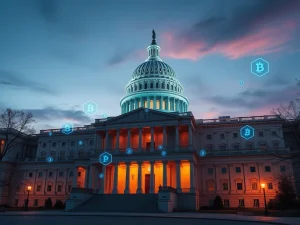Tether’s Pivotal Role: Unveiling the Urgent Stablecoin Decentralization Debate

In the dynamic world of digital finance, a recent action by Tether, the issuer of the world’s largest stablecoin, has once again thrust the crucial debate between centralization and decentralization into the spotlight. Following its latest freeze of nearly $86,000 in stolen USDt, Tether’s enforcement capabilities are under intense scrutiny, raising fundamental questions about control and sovereignty within stablecoin ecosystems. For anyone invested in the future of cryptocurrencies, understanding this evolving landscape is paramount.
Tether’s Growing Enforcement Power: A Closer Look at Crypto Compliance
Tether’s recent move, freezing $85,877 in USDt linked to stolen funds in collaboration with law enforcement, might seem like a minor event on its own. However, it’s part of a larger, escalating pattern. This action highlights the increasing role of centralized stablecoin issuers in enforcing crypto compliance, a stark contrast to the ethos of truly decentralized assets.
The company has openly stated its commitment to combating financial crime. According to Tether, it has frozen over $2.5 billion in USDt linked to illicit activity and blocked more than 2,090 wallets in cooperation with global authorities. This impressive record demonstrates a significant shift in how stablecoins are perceived and utilized.
Unlike cryptocurrencies such as Bitcoin and Ethereum, which are designed to be censorship-resistant with no single entity able to block or reverse transactions, Tether and other stablecoin issuers possess a unique capability. They can freeze their respective stablecoins at the smart contract level. This centralized control allows for rapid responses to hacks, scams, and regulatory pressures, making stablecoins powerful instruments in the fight against financial crime.
Why Centralized Stablecoins Are Potent Tools for Law Enforcement
Tether’s interventions have not been limited to small amounts. Several high-profile actions underscore their effectiveness as an enforcement tool:
- November 2023: Tackling Human Trafficking Scams: Tether froze a staggering $225 million in USDt from wallet addresses connected to a Southeast Asian human-trafficking and romance-scam network, often referred to as a ‘pig butchering’ scheme. This massive operation was executed in partnership with OKX, the U.S. Department of Justice, and the Secret Service, showcasing significant cross-organizational collaboration.
- June 2023: Enforcing Sanctions: In another significant move, Tether targeted 112 wallets holding approximately $700 million in USDt across the Tron and Ethereum blockchains. These funds were linked to Iran-related entities, and the freeze was widely seen as part of broader efforts to enforce U.S. sanctions amidst rising geopolitical tensions.
These actions reflect a growing perception of stablecoins not merely as digital representations of fiat currency but as active instruments of financial enforcement. Paolo Ardoino, Tether’s CEO, has publicly embraced this evolving identity. He stated in a March blog post, “Tether’s ability to track transactions and freeze USDt linked to illicit activity sets it apart from traditional fiat and decentralized assets. We take our responsibility to combat financial crime seriously and will continue working closely with global law enforcement agencies.” This stance firmly positions Tether as a key player in crypto compliance.
The Decentralization Dilemma: Is Tether a Stepping Stone to CBDCs?
While Tether’s enforcement actions are lauded by law enforcement and those seeking to recover stolen funds, they have ignited a fervent debate within the crypto community. Critics argue that if stablecoin issuers routinely cooperate with law enforcement and exercise such centralized control, the result could eerily resemble a Central Bank Digital Currency (CBDC), thereby undermining the core crypto values of financial sovereignty and decentralization.
Users on social media platforms like X have voiced strong concerns, labeling Tether’s recent actions as a “slippery slope.” One user questioned, “Can anybody explain how this isn’t exactly what a CBDC is?” This sentiment highlights a profound anxiety that the very tools designed to bring financial freedom could, ironically, lead to unprecedented levels of centralized control. Another user acknowledged the immediate benefit, noting that “centralized control has its moments” and that Tether’s quick response saved $85,000 from being lost. This encapsulates the tension: the practical benefits of intervention versus the philosophical implications for decentralization.
Stablecoins, CBDCs, and Decentralized Crypto: A Comparison
To better understand this critical debate, let’s compare the characteristics of Tether’s USDt, typical CBDCs, and truly decentralized cryptocurrencies like Bitcoin:
| Feature | Tether (USDt) | Central Bank Digital Currency (CBDC) | Bitcoin/Ethereum (Decentralized Crypto) |
|---|---|---|---|
| Issuer | Centralized company (Tether Ltd.) | Central Bank / Government | Decentralized network / Community |
| Control over Funds | Can freeze and blacklist addresses at smart contract level | Central authority can freeze, reverse, or control funds | Cannot be frozen or controlled by any single entity |
| Privacy | Pseudonymous, but transactions are traceable; issuer can identify users | Likely low to non-existent; high surveillance potential | Pseudonymous; higher degree of privacy, though transactions are public |
| Core Philosophy | Price stability, bridging fiat & crypto, some centralized control for compliance | Monetary policy control, financial inclusion, digital payments, surveillance | Financial sovereignty, censorship resistance, permissionless access, decentralization |
| Primary Use Case | Trading, DeFi, cross-border payments, store of value | Retail payments, wholesale transactions, government disbursements | Store of value, payments, smart contracts, decentralized applications (DeFi) |
This comparison illustrates why many in the crypto space view Tether’s capabilities with apprehension. While Tether operates as a private entity, its power to intervene in user funds mirrors a key concern often raised about CBDCs: the potential for a central authority to exert undue control over individual finances.
Navigating the Future: Balancing Security and Financial Sovereignty with Tether
The ongoing debate surrounding Tether’s enforcement power is not merely academic; it has tangible implications for the future of digital assets and how users interact with them. On one hand, the ability to freeze stolen funds provides a crucial layer of security, protecting victims of scams and aiding law enforcement in combating illicit activities. This is a clear benefit, especially as the crypto space matures and attracts more mainstream adoption.
On the other hand, the centralization inherent in such actions directly challenges the foundational principles of cryptocurrency: decentralization, censorship resistance, and financial sovereignty. For users, this raises important questions about trust and control. If a private company can freeze funds at will, even with good intentions, does it truly offer the same level of freedom as a decentralized asset?
What Does This Mean for Crypto Users?
- Due Diligence is Key: Users must understand the nature of the stablecoins they hold. Not all stablecoins are created equal in terms of their underlying mechanisms and centralized control.
- Diversification of Assets: Relying solely on centralized stablecoins for long-term holdings might not align with a pure decentralization philosophy. A diversified portfolio, including truly decentralized assets, can mitigate risks.
- Advocacy for Transparency: The crypto community can push for greater transparency from stablecoin issuers regarding their policies, the criteria for freezing funds, and their collaboration with authorities.
The tension between robust crypto compliance and the core values of decentralization is likely to persist. As the regulatory landscape evolves, stablecoin issuers like Tether will continue to navigate these complex waters, balancing the demands of law enforcement with the expectations of a community that values autonomy above all else. The future of digital finance may well depend on finding a sustainable equilibrium between these competing forces.
A Compelling Summary: The Unfolding Digital Frontier
Tether’s latest freeze is more than just an isolated incident; it’s a stark reminder of the fundamental choices facing the cryptocurrency ecosystem. As stablecoins become increasingly integrated into global finance, their centralized nature presents both powerful advantages in combating crime and significant challenges to the very ideals of decentralization. The ongoing dialogue about Tether, CBDCs, and financial sovereignty underscores a pivotal moment in crypto’s evolution. It forces us to confront whether we prioritize the security and efficiency offered by centralized control, or the radical freedom and censorship resistance promised by true decentralization. The path forward will undoubtedly require careful consideration, balancing the urgent need for a secure financial system with the enduring vision of a truly open and permissionless digital frontier.









